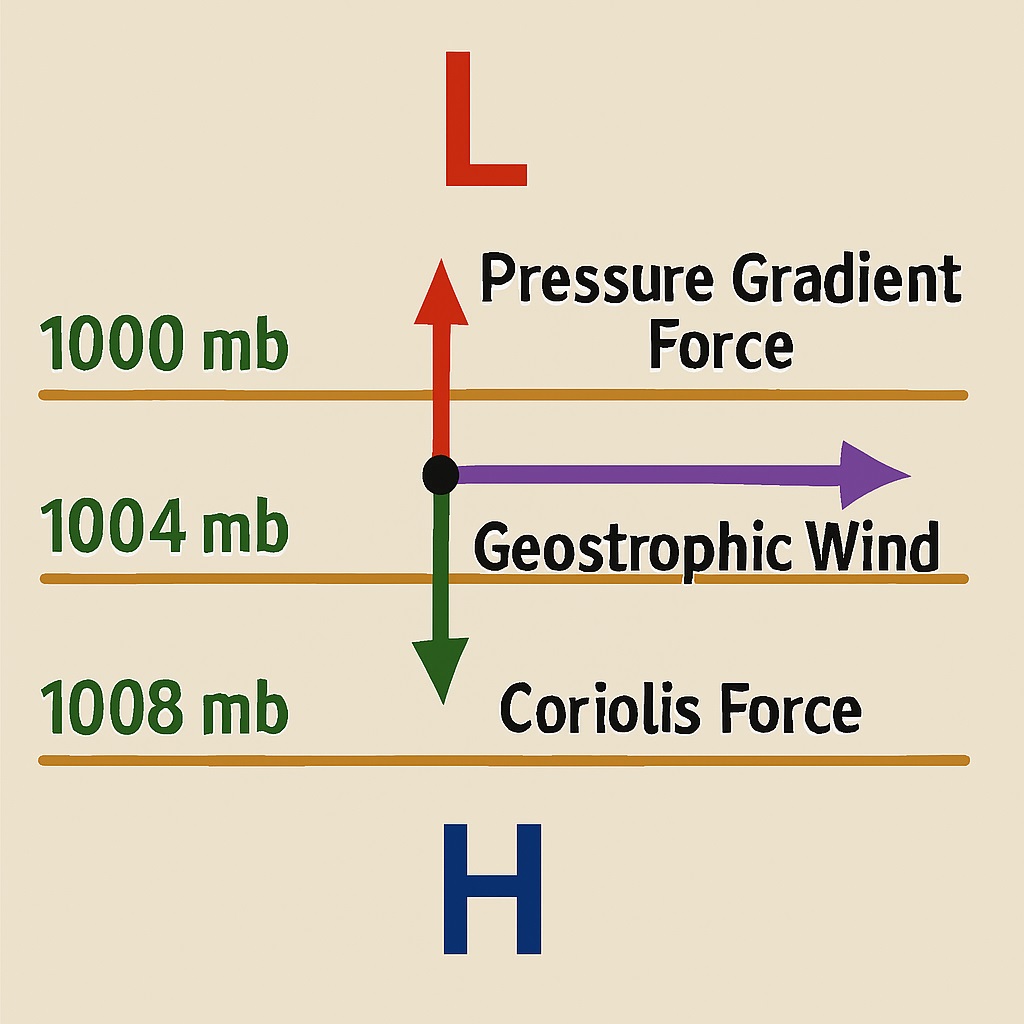Geostrophic wind is the horizontal flow of wind where the Coriolis force perfectly balances the pressure gradient force. In simpler terms, it represents the wind that blows parallel to the isobars (lines of equal pressure) at a given height above the Earth’s surface.

It is useful in understanding the large-scale horizontal airflow patterns in the Earth’s atmosphere. It plays a crucial role in weather forecasting, climate analysis, and understanding atmospheric dynamics.
Table of Contents
Factors Influencing Geostrophic Wind
Pressure Gradient Force
The pressure gradient force is the primary driver of this wind. It arises due to variations in atmospheric pressure over space. The magnitude and spatial distribution of the pressure gradient determine its strength. A steeper pressure gradient, indicated by closely spaced isobars, results in stronger geostrophic winds.

Coriolis Effect
The Coriolis effect is a consequence of the Earth’s rotation. It causes the deflection of moving objects, including air, to the right in the Northern Hemisphere and to the left in the Southern Hemisphere. The Coriolis force acts perpendicular to the wind direction and is directly proportional to the wind speed. The stronger the wind speed, the greater the deflection due to the Coriolis effect.

Latitude
Geostrophic wind is influenced by the latitude at which it occurs. As one moves away from the equator towards higher latitudes, the Coriolis effect becomes stronger. Consequently, geostrophic winds become more pronounced and exhibit a greater deflection from the pressure gradient.
Friction
Friction with the Earth’s surface can modify this wind patterns, particularly at lower levels of the atmosphere. Frictional effects slow down the wind and disrupt the geostrophic balance between the pressure gradient force and the Coriolis force.
"Near the surface, the wind generally flows across the isobars toward lower pressure due to the presence of surface friction."
Vertical Motion
Vertical motion within the atmosphere, such as upward or downward air movements associated with weather systems, can affect geostrophic winds. As air ascends or descends, it can disrupt the geostrophic balance, leading to changes in wind speed and direction.
Earth’s Surface Features
The presence of mountains, coastlines, and other topographical features can influence geostrophic wind patterns. These features can cause the wind to deviate from its ideal geostrophic path and result in local variations in wind direction and speed.
Importance of Geostrophic Wind
Geostrophic wind is of significant importance in meteorology and related fields.
Weather Forecasting
It plays a crucial role in weather forecasting. By understanding the balance between the pressure gradient force and the Coriolis force, meteorologists can analyze the movement and behavior of weather systems.
This wind patterns provide valuable insights into the track and intensity of storms, the formation and movement of weather fronts, and the development of high and low-pressure systems. This information helps forecasters make more accurate predictions about weather conditions, like the timing and location of precipitation, wind patterns, and temperature changes.
Large-Scale Atmospheric Circulation
The wind patterns contribute to our understanding of the large-scale atmospheric circulation. By studying the prevailing geostrophic wind direction and speed, meteorologists and climatologists can identify and classify major climate zones, such as the trade winds, prevailing westerlies, and polar easterlies.
Climate Analysis
It provides valuable information for climate analysis. By examining long-term geostrophic wind patterns, scientists can identify climate regimes, investigate changes in circulation patterns over time, and study climate variability. Geostrophic wind data helps in understanding the interaction between atmospheric dynamics, ocean currents, and other climate drivers, aiding in the development of climate models and projections.
Aviation and Air Traffic Management
The wind data is essential for aviation professionals and air traffic management. Airlines and pilots utilize geostrophic wind information to plan flight routes, estimate travel times, and optimize fuel consumption. Knowledge of prevailing wind patterns helps determine the most efficient flight paths and altitudes, reducing flight durations and improving fuel efficiency. It also assists in avoiding adverse weather conditions and turbulence, enhancing flight safety and passenger comfort.
Oceanography and Coastal Processes
It has implications for oceanography and coastal processes. Surface winds driven by geostrophic processes influence ocean currents and circulation patterns. Understanding this wind patterns is essential for studying coastal upwelling, coastal erosion, and the distribution of marine ecosystems. It also helps in the prediction of oceanographic events like the occurrence and movement of harmful algal blooms and the spread of pollutants.
In summary, geostrophic wind is a fundamental concept in meteorology with wide-ranging implications. It aids in weather forecasting, provides insights into large-scale atmospheric circulation, assists in climate analysis, supports air traffic management, and contributes to our understanding of oceanography and coastal processes. The study of geostrophic wind patterns helps us comprehend and predict various aspects of weather and climate, improving our ability to mitigate risks and make informed decisions.
Read: Geography Notes